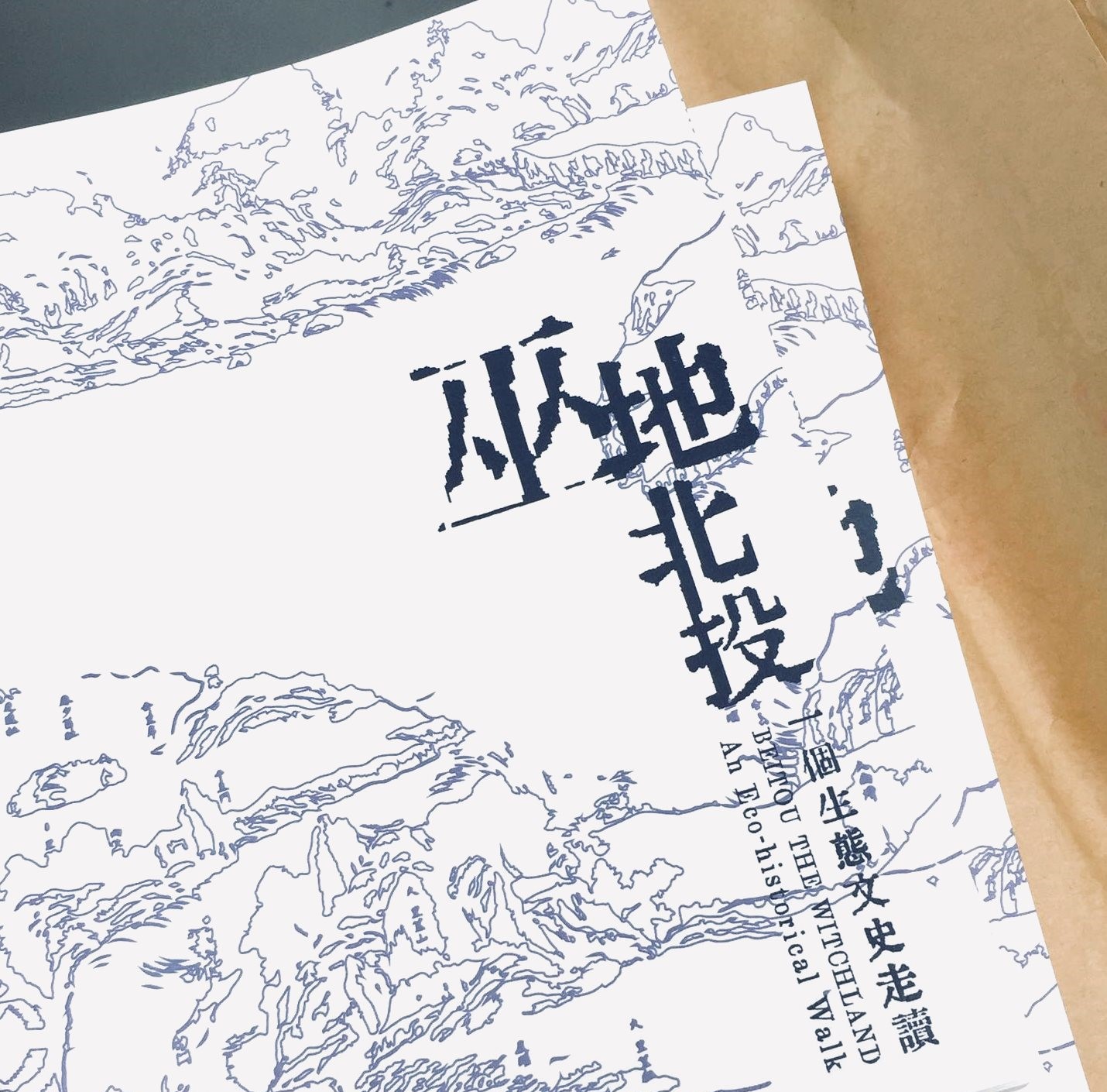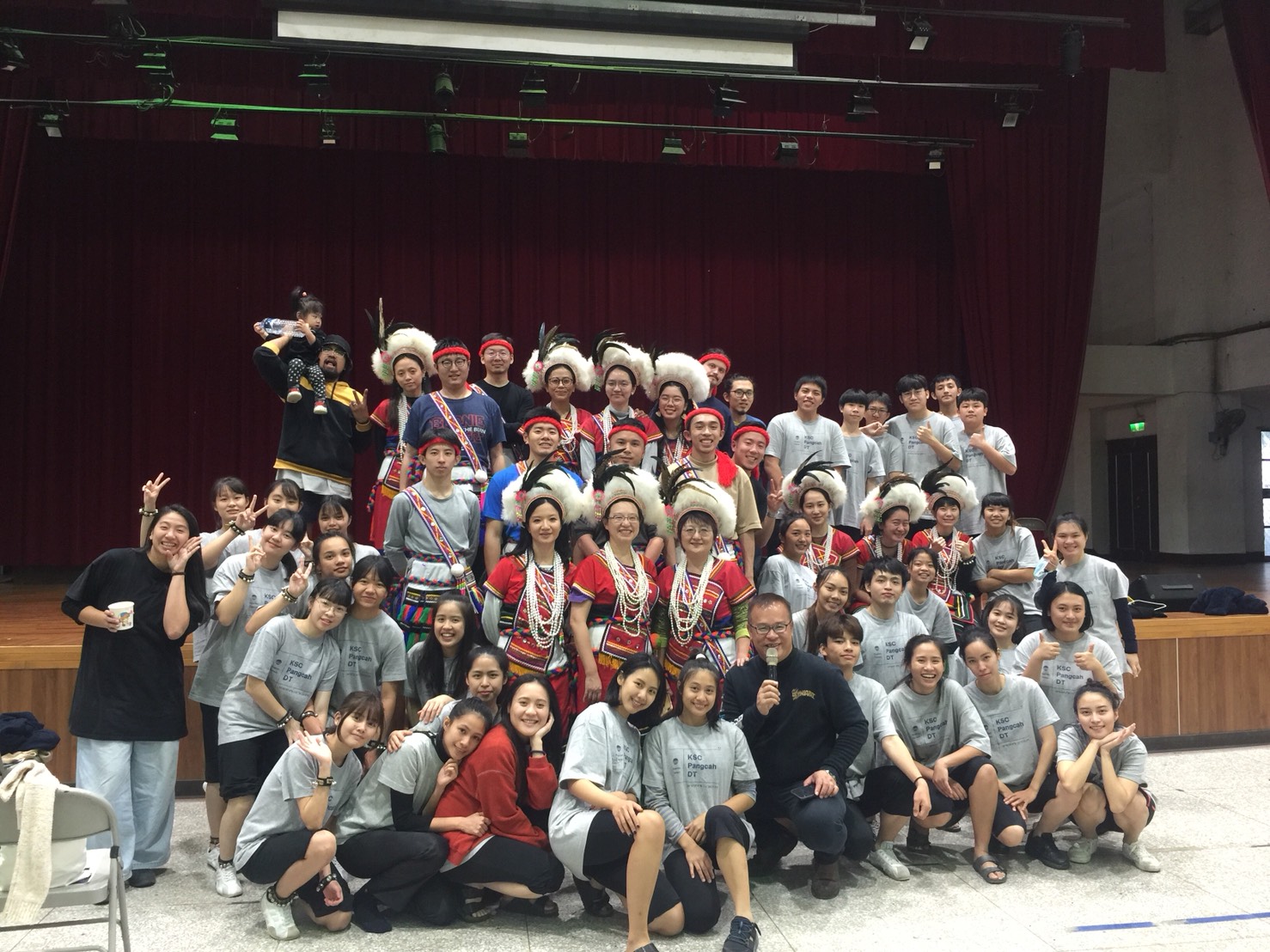
未來潮:大山地門當代藝術
由徐文瑞教授帶領的「策展實務專題」是這學期開放給IMCCI 學生修習的三堂藝術實務專題課程之一。這堂課的目的是理論化當代哲學脈絡下的策展實務,並開放給對策展實務有興趣且具有中文能力和組員溝通的研究生。學程鼓勵所有學生申請修習此實務課程,最後篩選出12位一起籌備展覽。
這場密集的課程提供珍貴的機會讓學生分工合作,並在組織「未來潮:大山地門當代藝術」展覽的過程中學習。這場展覽目前在屏東美術觀開放參觀。
北藝大徐文瑞教授是一位獨立策展人兼藝術評論家。他的研究主題著重在全球化的文化環境、美學與政治的關聯,以及地理政治環境下的當代藝術。徐教授在世界各地策劃多場國際型展覽,經常在亞洲、歐洲、美洲及澳洲各地協辦工作坊、會議與出版計畫。
「未來潮」是大山地門當代藝術展的第三個版本,展覽概念承接去年的「當斜坡文化遇見垂直城市」。這場獨特的展覽展出23位來自三地門鄉當代藝術家的作品,其中的12位藝術家也參與了去年的版本,今年加入11位原民藝術家。三地門鄉位於台灣南部的屏東縣,是個原住民社群。人口多數由排灣和魯凱族人組成。排灣族語裡,kacalisian 的意思是「住在斜坡上的人」,也是排灣與魯凱族人對自己的形容。
當代原民藝術家們在不同類型的藝術創作中,包含木雕、石雕、鐵雕、編織物、琉璃珠、陶壺、繪畫、錄像和多媒材裝置,展示自己的創意與技術。這些藝術品講述先祖的智慧如何與現代科技連結,創造未來的潛力。
參加這場展覽的藝術家有:力大古(蔡旺)、杜巴男、杜文喜、撒卡勒(彭水光)、巫瑪斯‧金碌兒(雷賜)、撒古流.巴瓦瓦隆、伊誕.巴瓦瓦隆 、巴勤發、峨塞.達給伐歷(李明義)、達比烏蘭‧古勒勒、 阿旦.達魯札隆、武玉玲、瑪斯斯格.金碌兒(雷斌)、古勒勒.羅拉登(雷恩)、杜寒菘、尼誕.達給伐歷、撒舒優.渥巴拉特、馬郁芳、拉夫拉斯‧馬帝靈、陳安琪、余欣蘭、磊勒丹‧巴瓦瓦隆、拉勒俄嵐‧巴耷玬(郭悅暘)。
這場為期8週的密集課程始於3月3日,當天徐教授為學生介紹山地門鄉的歷史脈絡、 作品概念、展覽空間、資金、時程,以及最重要的,學生們在組織這場展覽時扮演的角色。學生們在展覽開幕日,2020年4月17日之前,都必須每週到屏東。
第一次南下是在3月14日,一群興奮的學生在台北車站集合,準備搭上開往屏東的火車,開始為期5天的旅程。 學生們一抵達南方城市,就立即前往屏東美術館,與當地工作人員會合。他們負責在製作展覽的過程中幫助學生與藝術家。簡短概述計畫後,學生策略性地分成各個組別,包含空間設計、入口設計、行銷、教育計畫、手冊設計、中英翻譯和影片組。學生可以選擇自己有興趣或符合專業能力的組別。有些人不只在一個組別,他們就必須妥善安排自己的時間來處理工作量。
從第一天到達屏東,學生們立刻著手自己的任務,為的就是在4月16日,非正式開幕日前完成目標。各組的工作檔案都放在雲端,好讓每個人都知道彼此的進度。此外,因為工作量大,學生每週傍晚都需要與徐教授通話,討論工作狀態與更動。
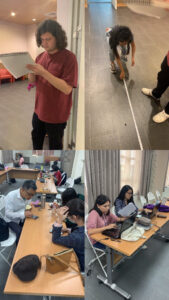
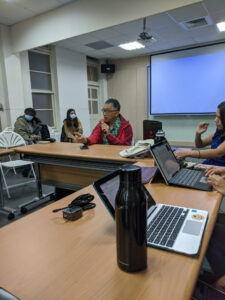
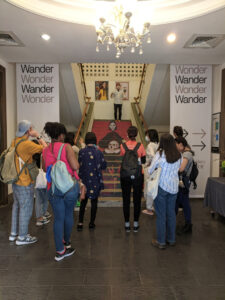
Photos by Larissa Soto and Claudia Bermúdez
這場展覽旨在帶領觀眾走一趟台灣原民藝術的過去到現在,讓他們一窺未來的樣貌。IMCCI學生們的任務是海報與手冊設計、過程記錄、教育活動、地圖設計和翻譯。學生從策展過程中獲取實戰經驗,並體驗台灣另一個縣市的生活。屏東的生活跟台北有很大的差異。這個小城市的人口比台北少,也比都市還更方便步行、騎腳踏車。
展覽籌備與佈置的這段時間,許多組別都在連續的幾個週末到屏東確認設計配置、採訪藝術家、準備不同形式的廣告和紀錄片。大部分的工作在事前安排的線上或實體會議就已完成。Grace這組和同學的溝通是透過線上通訊平台跟好幾份新上船或編輯過的Google資料夾。Line是後面主要的溝通媒介。機動的組別從建築、平面設計到攝錄影甚至是社群軟體都能成功提供支援。除了運用現有技能,學生也在其他領域學習或支援,讓展覽在緊迫的期限中順利完成。
不管是跨文化溝通或協助展覽的機會,這次經驗都讓人既期待又怕受傷害。身為一群國際學生,溝通是經常在教室內會遇到的挑戰。英語是最普及的第二語言,但學生在展覽中面臨的現實是另一個挑戰。大多數人的中文能力不足,對原民語言也一知半解。工作的一部分挑戰是將中文翻成英文,但還是完成了。社群媒體的貼文內容經常是寫好的英文,之後再翻成中文,以觸及更多觀眾。
紀錄組大概是最忙碌和全神貫注的,他們擁有獨一無二的機會前往工作室拜訪藝術家。紀錄二人組花了超過一星期和每位藝術家見面並採訪,同時也了解他們如何創作和受到什麼樣的啟發。他們的最終成品是每位藝術家的訪談影片,談論對於此展覽的關鍵字「未來家」 的理解、鼓勵並吸引大眾前來觀展的宣傳影片,以及介紹這項專案的最終影片,每位參與者在裡面講述他們的貢獻。紀錄組的組員在運用現有技能的同時,也在陌生的領域摸索著。
對各組而言,總有屬於自己的挑戰。展覽策劃是學生不熟悉的領域,因此學到的東西無法衡量。讓學生主動策劃一場真正的展覽,或許是展示策展概念最好的方式。這是一堂非常成功的實務課程,因為學生可能無法忘卻這段時間的情感和實際經歷。
這群人也必須注意新冠肺炎跟控制疫情擴散的規定變化,添上一筆策展挑戰,包含遵守國家衛生指揮中心中央流行疫情指揮中心(CECC)的規定。組織團隊必須調整或取消某些計畫好的活動。這些活動包含工作坊、分享原民知識的小型集會,是教育活動組和展覽一些藝術家合作下的成果。希望這些活動在展覽結束,2020年8月17號前,可以恢復舉行。
展覽開幕倒數一週
展覽開幕倒數前一週同時也是新冠肺炎期間,學生們動身前往屏東,這是他們最後一趟跟展覽有關的旅程。這趟旅程跟前面幾趟有明顯不同。由於新的限制措施,學生們在擔心健康安全之餘,展覽的訪客規定跟互動計劃都有重大改變。許多組別預計實施的想法都必須調整。但是,最後一週或許是整堂實務課中最令人感到實際和身歷其境的,可能與親自在場跟一切都準備就緒的興奮感有關。
這週學生們密集地與藝術家合作設置作品,包含展示盒、展示牆上色,和藝術家武玉玲學習編織,跟安裝數位媒體展品。具有挑戰性,但又有教育性質。
最後一週也是文化交流的高峰,因為IMCCI學生們和不同藝術家共事。他們能學習更多藝術家的想法、信念,藝術家也能了解學生們的文化背景。參與此檔展覽真的是一次價值無限的創造性機會。
創造性機會的一個成功例子是我們一位碩二學生,她在最後一週密集地與武玉玲合作,用原民編織技術作為創作表述的媒介。來自秘魯的碩二學生,Yesenia Loayza 從武玉玲身上學到多樣編織技術,並能夠幫她設置藝術作品。由於這次經驗,武玉玲邀請Yesenia,同時也是祕魯克丘亞部落的成員(祕魯原住民),和她一起準備今年稍後的另一場展覽。同時,IMCCI其中一位碩一學生也受到另一位原民藝術家-伊誕.巴瓦瓦隆的鼓勵,參加九月的藝術駐村計畫。
一個月前還空蕩蕩的博物館在我們見證下讓這場展覽發生、粗略的草圖轉變成可投影的3D虛擬模型,這些都是最令人滿意的部分。看見我們的想法跟建議被實踐,成就感跟驕傲是我們作為團隊最有感的字眼。在最終的佈展日4月16日,我們蠻晚才離開美術才離開美術館,因為我們完成了所有事。每件事都準備就緒,等待星期五的開幕。
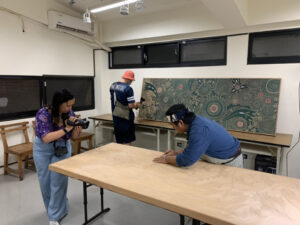

Photos by Larissa Soto and Yesenia Loayza
開幕之日,所有修習課程的學生都出席了記者會和第一場導覽,這場導覽由徐文瑞策展人帶領觀眾走過每個展間和每件藝術品,由每位藝術家親自講解作品傳達的理念和在展覽中貢獻的部分。
在這學期的策展實務課程從事屏美館的展覽籌備,在很多層面上都具有教育性。能參與台灣原民歷史、藝術和目標是很獨特的機會。此外,這也是和台灣藝術產業、策展過程產生緊密連結的一個機會。除了提供學習和沉浸在藝術的機會,也讓我們可以自由運用和發展我們的技能和天分。我們投入的時間、精力、想法換來的是豐富的知識、友誼跟人生回憶,也提供一些學生實習經驗跟未來的可能合作機會。
這場創新性展覽邀請觀者重新思考原民概念,以及運用未來學方法開啟關於原民性的對話。以策展人的話來說:「未來潮 試圖從原民性的角度,從人類與土地、其他物種、深層生態的關係出發,探討原住民當代藝術如何連結過去與現在的泉源,並創造未來的潛在力量。」
By Claudia Bermudez and Melody Wagner
IMCCI year 1 students
English Version
The “Curatorial Seminar”, taught by Professor Manray Hsu, was one of the three different art seminars opened for IMCCI students to enroll this semester. The objective of this course was to theorize curating in the context of contemporary philosophy. It was designed for postgraduate students that have an interest in curatorial practices and that are able to speak in Chinese in order to facilitate communication with the group. All the students were encouraged to apply to the seminar and after going through a selection process, only twelve students were chosen to participate in the exhibition.
The intense seminar provided an invaluable, one of a kind opportunity to collaborate and learn from the process of organizing the exhibition “Futurist Wave: Contemporary Art from Greater Sandimen”, that is currently open at the Pingtung Art Museum.
TNUA Professor, Manray Hsu is an independent curator and critic. His intellectual work focuses on cultural conditions of globalization, the relationship between aesthetics and politics, and geopolitical situations of contemporary art. Hsu has curated several international exhibitions around the world and often collaborates on workshops, conferences and publications in Asia, Europe, America and Australia.
“Futurist Wave” is the third edition of Contemporary Art From Greater Sandimen. The concept of this exhibition follows the sequence from last year’s exposition “When Kacalisian Culture Meets the Vertical City.” This unique exhibition showcases the artwork of twenty-three contemporary artists from the Sandimen township, twelve of these artists also participated in the previous event, and are joined now by eleven indigenous artists. Sandimen is an indigenous community located in Pingtung county, in southern Taiwan. Its population is composed mostly of Paiwan and Rukai people. In Paiwan language kacalisian means “people who truly live on the slope” and it is the self-description of the Paiwan and Rukai tribes.
Contemporary indigenous artists showcase their creativity through different techniques and works of wood and stone carving, iron sculpture, weaving, glazed beads, clay pot, painting, video and multimedia installation. Their artworks talk about how art can connect the wisdom of past ancestors with the current technology to create the potential of the future.
The artists participating in this exhibition are: Sakale Savalju, Lidaku Mabaliu, Arulhadenge Valialane, Arase Salrebelrebe, Pakidafi Rusanokan, Sakuliu Pavavaljung, Ruladen Family, Umass Zingrur, Kulele Ruladen, Masiswagger Zingrur, Tapiwulan Kulele, Cemelesai Takivalit, Thalaelethe Titibu, Rngrang Hungul, Etan Pavavaljung, Sasuyu Ubalat, Ljaljeqelan Patadalj, Reretan Pavavaljung, Aluaiy Pulidan, Aruwai Matilin, Nitjan Takivalit, Lavuras Matilin, Pacake Taugadhu and Adan Dalujalung.
The eight-week intense seminar started on March 3, with a class introduction where Professor Hsu contextualized students with the history of Sandimen, the concept of the artworks, exhibition space, funding, scheduling and most importantly the role of the students in the process of organising the new exposition. Students were required to travel to Pingtung every weekend until the exhibition opening date, scheduled for April 17, 2020.
The first trip to the south was made on March 14, the excited group of students gathered at Taipei Main Station, ready to start the five-hour journey on board the local train that would take them to Pingtung. As soon as the students arrived in the southern city, they went straight to the Pingtung Art Museum where they met with part of the staff that works there. They were in charge of supporting the students and the artists in the process of making the exhibition. After a brief overview of the project, the team strategically divided the different tasks into teams, such as space design, entrance design, promotion, educational program, booklet, Chinese-English translation and documentation team. Therefore, students had the option to choose to work in the group or groups that best suited their abilities and professional background. Some scholars were part of two or three different groups, which meant they had to organize their time wisely to cope with the workload.
Since the first day of arriving in Pingtung, students started working on their assigned tasks in order to complete the goal and meet the designated deadline, which was April 16, one day before the unofficial opening. To keep everyone informed about each group’s improvement, an online folder was created which contained subfolders for each team to upload their work at any time. Also, due to the heavy workload every week scholars had late evening conference calls with Professor Manray to discuss the status of work and make changes if required.
The exhibition sought to give its audience a historical walk through Taiwanese Indigenous Art from past to present and give them a sneak peak into what the future might be. IMCCI students were tasked with developing the flyer and brochure design, documenting the process, educational programming, map designing and translation. Working on the exhibition meant experiential learning for students, it gave them the opportunity to experience the complete process of curating an exhibition as well as getting to live and experience life in another Taiwanese county. Life in Pingtung was significantly different from what can be experienced in Taipei. The small community could be described as a small town with less people and easier to navigate by foot and bike than Urban Taipei.
Between the time of the exhibition’s installation and the student’s first trip to Pingtung several small teams took consecutive trips to identify placement of designs, collect interviews with artists and other forms of media for the advertisement and documentation of the processes. Most of the work was done off location through pre-arranged meetings either virtually or in person. Communication between Grace’s team and the students was facilitated through the online messaging platform with continuous uploads to the google folders of new editions of documents. Line was the main communication medium used for the latter part of the process. The dynamic group that ranged from Architects and Graphic Designers to Videographers and Photographers and even Social Media Managers were able to successfully provide support within their individual fields of expertise. Beside using pre-existing skills, students also lent their support and learning about other technical fields to facilitate the project that came with a short deadline.
The experience with both cross cultural communication and the opportunity to assist with this exhibition was both exciting and intimidating. As a group of International Students the challenge of communication was something often faced in the classroom, with the most speaking English as a second language, however for the exhibition, students were challenged with yet another reality. The majority had even less chinese language ability and no grasp of indigenous languages. A part of the task at hand was to translate content from Chinese to English which was challenging, however it was completed. For social media posts content was often written and edited in English and later translated to Chinese so that it could reach a wider audience.
The documentation group were perhaps one of the more hands on and immersed, they had the unique and priceless chance to visit the artist in their workshops and studios. The duo spent over a week meeting and interviewing each artist while also understanding how they created their works of art and what inspired them. The end product of their labour was a profile video with each artist speaking on their understanding of one of the key terms of the exhibition “Futurist”, a promotional video that engaged and encouraged public to visit the exhibition and a final video of what the project was about, where each participant got to speak about their contributions and takeaway from the project. Members of that group, employed pre-existing skills while also tinkering with foreign fields.
For each team, there was a level of challenge, in the sense that the process of the exhibition curation was not something students were familiar with, therefore the lessons gained are countless. It was perhaps the best way to demonstrate the concept of curation, having students actively curate an actual exhibition. This was a very successful seminar as students will probably never forget the emotional and physical experience endured during the process.
Added to the challenge of curating an exhibition, the group also had to be attentive of the Corona Virus and the changing regulations that were being enforced to control it’s spread. This included following the regulations suggested by the Central Epidemic Command Center (CECC) the organizing team had to adjust or cancel some activities that were planned for the project. Some of these activities included workshops and small gatherings focused on sharing indigenous knowledge with the community. These efforts were part of an enriching educational program that was made by the scholars in collaboration with some artists for the exhibition. Hopefully, these activities can be resumed before the exhibition ends on August 17, 2020.
The Countdown – 1 Week to Opening
The week before the soft launch and opening, students embarked on their final exhibition related journey to Pingtung, in a Covid-19 conscious time. This trip was markedly different from previous as new restrictions and enforcements were in place which in many ways raised concerns for students about health and safety while also significantly altering plans surrounding interactions and visitor expectations for the exhibition. That in mind, several of the initial ideas that some teams sought to carry out had to be adjusted. However, lessons of the last week were perhaps more of a practical and immersive manner than the complete duration of the course. This could probably be linked to the excitement of the set up as well as being on site.
During this week students worked closely with artists to set up their works, from painting display boxes to walls, learning how to weave with artist Aluaiy Pulidan setting up and seeing digital media displays. It was challenging but educational and transformational, from one day to the next we could see the difference and between the documentation and publicity team students were able to take viewers on that journey.
The final week was also the peak of the cultural exchange as the IMCCI Scholars worked with the different artists. During that time they were able to learn more about the artists their ideas, beliefs while the artist learned about the backgrounds and culture of students. Working on the exhibition was a priceless and immeasurable creative opportunity.
Among some of the success stories was the opportunity that one of our second year students had to work for the full final week closely with Aluaiy Pulidan who uses indigenous weaving techniques as her chosen medium of expression. Peruvian second year student, Yesenia Loayza learned from Pulidan various weaving techniques and was able to help her with setting up her artwork. Following that experience Pulidan has offered Yesenia, a member of Peru’s Quechua Community (Indigenous of Peru) the invitation to work with her on another art exhibition later this year. On that same wave, one of our first year IMCCI students is being encouraged by another one of the indigenous artists Etan Pavavaljung to undertake a residency in September.
Witnessing the empty museum transform into the exhibition we had 1 month ago only had rough sketches and later projected onto a 3-D virtual model was one of the most satisfying feelings. Accomplishment, completion and pride are only a few of the words that could describe how we felt as a team, seeing our ideas, our work and our suggestions being used. On the final set up day April 16th, we left the museum pretty late, but we left it completed, with everything in place for Friday’s launch.
The day of the launch, all the students of the seminar were present for the press conference and first tour, where artists, and the main curator addressed the audience and conducted a guided tour of the exhibition. The group went from one installation room to another witnessing the works and hearing each artist explain what their work represented and how it contributed to the exhibition.
Working on the PTAM Exhibition through this semester’s Curation Seminar was educational on so many levels. It was a unique opportunity to engage with Taiwanese Indigenous history, art and goals. Additionally it was the chance to make intimate connections with the Taiwanese Art Industry as well as the curation and exhibition processes. Beyond the learning and exposure that it provided it was a free space for us to apply and develop our technical skills and talents, our investment of time, energy, ideas was abundantly compensated with new knowledge, friendships and life memories. It also produced internships and possible future collaboration opportunities for some students.
This innovative exhibition invites the visitors to rethink the indigenous concept and to start a conversation about indigeneity with a futuristic approach. In the words of the curator, “Futurist Wave attempts to explore the relationship between humans and land, other species, and deep ecology from the perspective of indigeneity, and explore how the aboriginal contemporary art connects the fountains of the past and present and creates potential forces for the future.”
By Claudia Bermudez and Melody Wagner
IMCCI year 1 students



